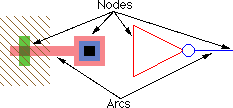1-6: Fundamental Concepts |
1-6: Fundamental Concepts |
ELECTRIC IS DIFFERENT because it uses connectivity for all design, even Integrated Circuit layout. This means that you place components (MOS transistors, contacts, etc.) and draw wires (metal-2, polysilicon, etc.) to connect them. The screen shows the true geometry, but it knows the connectivity too.
The advantages of connectivity-based IC layout are many:
The disadvantages of connectivity-based IC layout are also known:
| The way that Electric handles all types of circuit design is by viewing it as a collection of nodes and arcs, woven into a network. The nodes are electrical components such as transistors, contacts, and logic gates. Arcs are simply wires that connect two components. Ports are the connection sites on nodes where the wires connect. |  |
In the above example, the transistor node has three pieces of geometry on different layers: polysilicon, active, and well. This node can be scaled, rotated, and otherwise manipulated without concern for specific layer sizes. This is because rules for drawing the node have been coded in a technology , which describes nodes and arcs in terms of specific layers.
Because Electric uses nodes and arcs for design, it is important that they be used to make all of the relevant connections. Although layout may appear to be connected when two components touch, a wire must still be used to indicate the connectivity to Electric. This requires a bit more effort when designing a circuit, but that effort is paid back in the many ways that Electric understands your circuit.
A cell is a collection of these nodes and arcs, forming a circuit description. There can be different views of a cell, such as the schematic, layout, icon, etc. Also, each cell view can have different versions, forming a history of design. Multiple views and versions of a cell are organized into Cell groups.
For example, a clock cell may consist of a schematic view and a layout view. The schematic view may have two versions: 1 (older) and 2 (newer). In such a situation, the clock cell contains 3 cells: the layout view called "clock{lay}", the current schematic view called "clock{sch}", and the older schematic view called "clock;1{sch}".
Hierarchy is implemented by placing instances of one cell into another. When this is done, the cell that is placed is considered to be lower in the hierarchy, and the cell where it is placed is higher. Therefore, the notion of going down the hierarchy implies moving into a cell instance, and the notion of going up the hierarchy implies popping out to where the cell is placed. Note that cell instances are actually nodes, just like the primitive transistors and gates. By defining exports inside of a cell, these become the connection sites, or ports, on instances of that cell.
A collection of cells forms a library, and is treated on disk as a single file. Because the entire library is handled as a single entity, it can contain a complete hierarchy of cells. Any cell in the library can contain instances of other cells. By declaring exports inside of the cell definition, their instances properly interface at higher levels of the hierarchy.
Besides creating meaningful electrical networks, arcs which form wires in Electric can also hold constraints. A constraint helps to control geometric changes, for example, the rigid constraint holds two components in a fixed configuration while the rest of the circuit stretches. These constraints propagate through the circuit, even across hierarchical levels of design, so that very complex circuits can be intelligently manipulated.
| Previous | Table of Contents | Next |